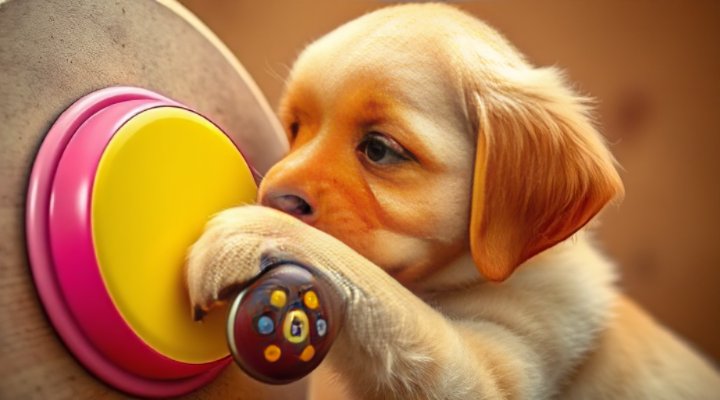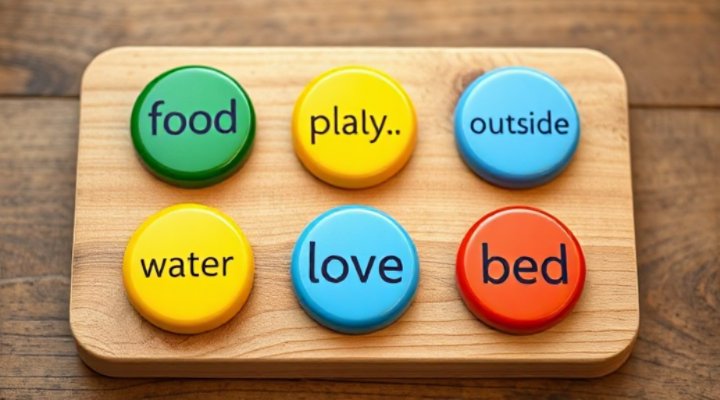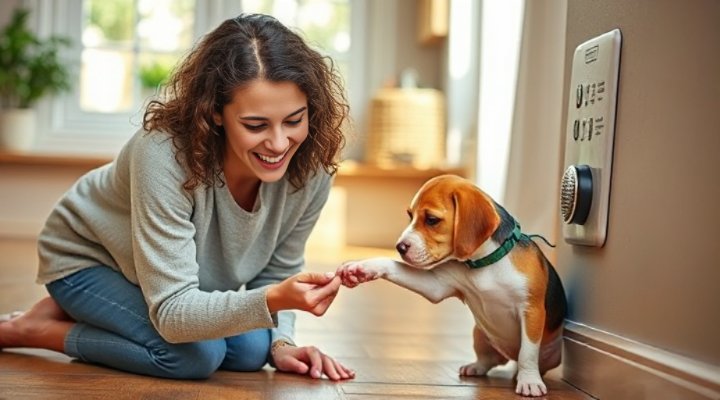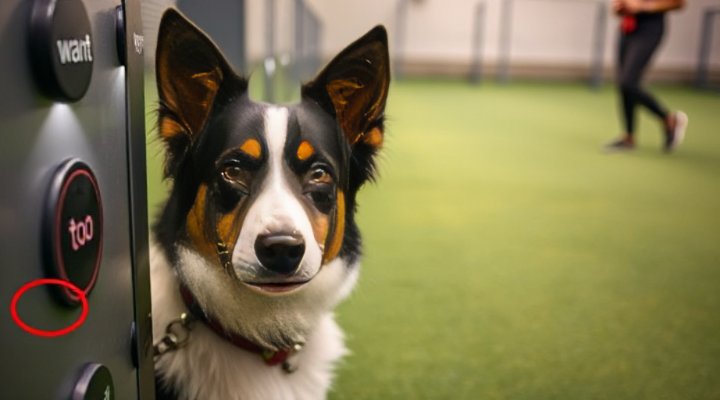Dog buttons training is revolutionizing how we communicate with our canine companions. Imagine your dog being able to tell you when they’re hungry, want to play, or need to go outside – all by pressing simple buttons! This innovative method builds on your dog’s natural intelligence and desire to communicate with you.

Getting Started with Dog Buttons Training
Before diving into dog buttons training, you’ll need some basic equipment. The most important items are the communication buttons themselves. These are typically large, durable buttons that can withstand paw presses. You can find specialized dog communication buttons or make your own using recordable buttons.
Start with just 2-3 buttons for basic needs like ‘food’, ‘outside’, and ‘play’. As your dog masters these, you can gradually add more buttons to expand their vocabulary. Remember, consistency is key in dog training, so place the buttons in a permanent location that’s easily accessible to your pet.

Teaching the First Button
The first button is often the hardest to teach. Choose something highly motivating for your dog, like ‘food’ or ‘play’. Here’s a simple step-by-step process:
- Say the word clearly while performing the action (e.g., ‘Food’ while preparing their meal)
- Press the button yourself immediately after saying the word
- Repeat this consistently for several days
- Encourage your dog to press the button with their paw before getting what they want
Be patient – some dogs pick this up quickly while others may need weeks of practice. Positive reinforcement through treats and praise will help speed up the learning process. For more basic training techniques, check out our comprehensive guide.

Expanding Your Dog’s Vocabulary
Once your dog has mastered their first button, you can begin adding more. Introduce new buttons one at a time, spacing them out by at least a week. This prevents confusion and ensures your dog truly understands each button’s meaning before moving to the next.
Some popular additional buttons include:
- Water
- Walk
- Love (for affection)
- Bed
- Help (for when they need assistance)
Interestingly, many dogs begin to combine buttons to form simple ‘sentences’ like ‘Play outside’ or ‘Food water’. This demonstrates their remarkable ability to understand and use this communication system creatively.
Troubleshooting Common Challenges
Like any dog training method, button communication comes with its challenges. Some dogs may become overly enthusiastic, pressing buttons repeatedly. Others might seem disinterested at first. Here are solutions to common issues:
Problem: Dog presses buttons randomly
Solution: Only respond to appropriate button presses. Ignore random presses to avoid reinforcing this behavior.
Problem: Dog won’t press buttons at all
Solution: Make sure the buttons are easy to press. You might need to demonstrate more or use higher-value rewards initially.

The Science Behind Dog Buttons Training
What makes dog buttons training so effective? It taps into several principles of canine cognition and learning:
- Associative learning: Dogs naturally associate sounds with actions or objects
- Operant conditioning: The button press becomes a behavior that produces a desired outcome
- Symbolic communication: Dogs can learn that buttons represent specific concepts
Research shows that dogs have the cognitive ability to understand hundreds of words and concepts. Button communication simply gives them a way to express this understanding. For dogs with behavioral challenges, this method can be particularly helpful in reducing frustration.
Real-Life Success Stories
Many pet owners have transformed their relationships with their dogs through button communication. Take Bella, a Labrador who learned to tell her owners when she was feeling unwell by pressing the ‘help’ button. Or Max, who combines ‘love’ and ‘mom’ when he wants cuddles from his favorite person.
These stories demonstrate the profound emotional connection that dog buttons training can foster. It’s not just about meeting basic needs – it’s about understanding your dog’s thoughts and feelings on a deeper level.
Advanced Button Communication
For dogs who master the basics, the possibilities are endless. Some owners create elaborate button boards with dozens of options. Others teach their dogs to answer simple questions or express preferences.
Advanced techniques include:
- Teaching ‘yes’ and ‘no’ buttons for simple questions
- Adding emotional buttons like ‘happy’ or ‘scared’
- Creating button combinations for complex ideas
- Introducing buttons for names of family members
Remember, every dog learns at their own pace. What matters most is the quality of communication you build with your pet, not the number of buttons they can use. For more obedience training ideas, explore our related articles.
Maintaining Your Dog’s Button Skills
Like any skill, button communication needs regular practice. Here are tips to keep your dog’s abilities sharp:
- Use the buttons consistently in daily routines
- Rotate buttons occasionally to prevent boredom
- Challenge your dog with new combinations
- Record and celebrate their progress
Most importantly, have fun with the process! Dog buttons training should be an enjoyable experience for both you and your pet. The stronger your bond, the more effective the communication will be.
Related Keywords: dog communication buttons, teaching dog to use buttons, dog training techniques, pet communication tools, basic dog training
